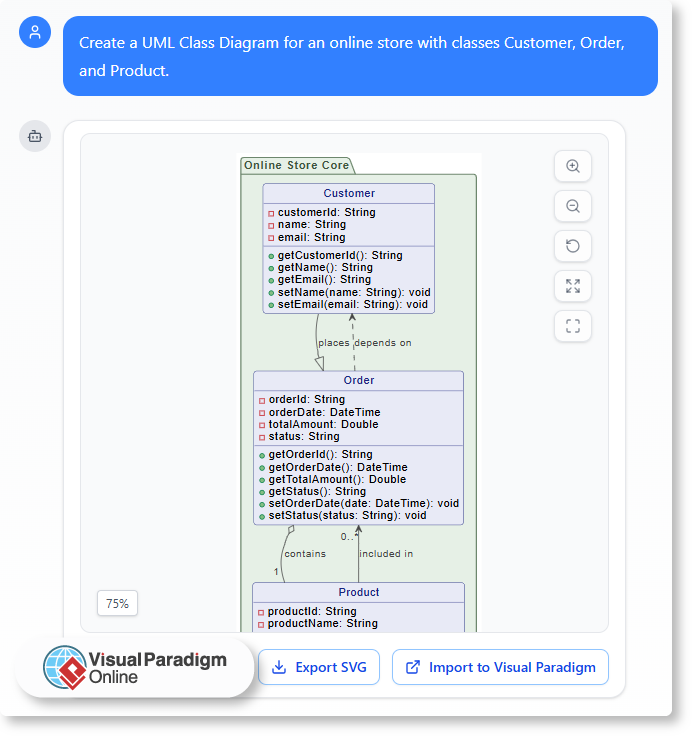For years, creating diagrams meant manually dragging shapes, aligning connectors, and labeling components. It was precise but time-consuming.
Now, AI-powered tools like the Visual Paradigm Online AI Chatbot have transformed how diagrams are made — turning text prompts into complete UML, BPMN, or flow diagrams in seconds.
But which method fits your workflow better: AI or manual diagramming? Let us explore the pros and cons of each, and how combining both delivers optimal results.
Manual Diagramming: Total Control with More Effort
Manual diagramming has long been the standard approach for professionals. It gives full creative freedom — every element, layout, and connection is crafted exactly as intended.
Advantages:
- Full design control: You decide the layout, naming, and visual details.
- Better conceptual understanding: Drawing shapes manually deepens comprehension of system logic.
- High customization: Ideal for refining presentations and meeting specific visual standards.
Challenges:
- Time-consuming: Complex diagrams can take hours to perfect.
- Repetitive adjustments: Minor changes may require extensive rearrangement.
- Steep learning curve: Beginners often struggle with modeling notation and best practices.
Manual diagramming remains valuable for experienced modelers who need accuracy, but it demands more time and effort.
AI Diagramming: Speed and Simplicity at Scale
AI-driven diagramming tools like Visual Paradigm Online’s AI Chatbot use natural language to create diagrams automatically.
You simply describe what you need — for example:
“Create a UML Class Diagram for an online store with classes Customer, Order, and Product.”
Within seconds, the tool generates a structured, ready-to-edit diagram.

Advantages:
- Instant results: Generate complete diagrams in moments.
- No modeling expertise required: AI handles syntax and structure automatically.
- Great for brainstorming: Quickly visualize early-stage ideas or compare multiple versions.
Challenges:
- Less control over layout: AI focuses on accuracy, not presentation aesthetics.
- Limited creative fine-tuning: Some customization still requires manual editing.
- Dependent on prompt clarity: Results vary with how well the request is described.
AI diagramming excels in speed, accessibility, and automation — especially useful for quick iterations or concept validation.
Finding the Balance: Why You Need Both
Rather than choosing one approach, modern workflows benefit most from AI-assisted manual editing.
The Visual Paradigm Online AI Chatbot integrates both worlds in a single environment:
Start with AI generation — instantly create your base diagram from text.
- Ask AI for adjustments or explanations — such as “Add an inheritance relationship” or “Explain this interaction.”
- Switch to manual editing — refine, reposition, and style elements directly in the editor.
This hybrid approach saves time while preserving full control, allowing you to stay productive from brainstorming to final documentation.
Real-World Use Cases
- Software Designers: Use AI to draft UML diagrams, then fine-tune manually for precise system documentation.
- Business Analysts: Generate BPMN or flowcharts for meetings, then refine key steps for clarity.
- Students & Educators: Learn UML or process modeling faster with real-time examples and feedback.
Each use case benefits from AI efficiency without losing manual precision — a balance ideal for professional and educational environments alike.
The Best of Both Worlds with Visual Paradigm Online
Visual Paradigm Online provides an integrated modeling workspace that supports AI-assisted creation and manual refinement seamlessly.
You can:
- Generate diagrams from natural-language prompts.
- Request AI-based explanations or improvements.
- Edit every element manually in the visual editor.
- Save and share your work in the cloud instantly.
By merging automation and human creativity, it ensures your workflow is both fast and flexible — without sacrificing quality or clarity.
Conclusion
AI and manual diagramming each have unique strengths. Manual design offers precision and control; AI provides speed and simplicity.
The Visual Paradigm Online AI Chatbot combines both, allowing you to start fast, refine easily, and deliver professional results in less time.
Whether you are designing systems, mapping processes, or learning UML, this balance ensures your diagrams truly fit your workflow.